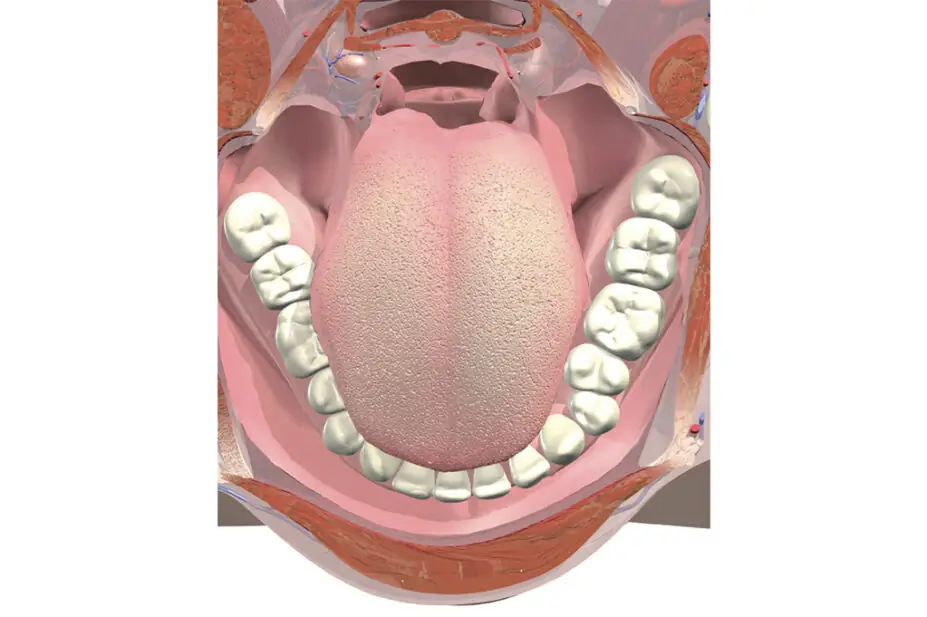
MEDICAL IMAGES, UNIVERSAL IMAGES GROUP/SCIENCE PHOTO LIBRARY
Oral administration of medicines still enjoys a hallowed place in drug delivery systems and, unsurprisingly, still takes the lion’s share of the pharmaceuticals marketplace. although it is a convenient route of delivery, there are some disadvantages with swallowing some medicines, for example, the harsh conditions of the gastrointestinal tract, the multiple degrading enzymes and extensive hepatic first-pass metabolism.
Injections can overcome some of these disadvantages but it is at the expense of patient compliance. More functionally, the ability physically to swallow a medicine is another cause for concern in certain patient groups, such as geriatric, paediatric and psychiatric patients.1
The oral mucosal cavity, one of the transmucosal routes, offers an alternative to the conventional oral route for systemic drug delivery due to several favourable properties. It allows direct access of drugs to the systemic circulation via the internal jugular vein, therefore bypassing liver metabolism. Its robust epithelium can withstand repeated dosage form administration without any permanent damage. also, it is easily accessible and associated with good patient compliance.
Buccal and sublingual dosage forms are intended either to act locally (eg, Orabase paste containing carmellose sodium) or to exert a systemic effect (eg, prochlorperazine buccal tablets, glyceryl trinitrate buccal mucoadhesive tablets and nicotine chewing gum).
Drug transport across the epithelium is primarily via intercellular spaces, with the rate of penetration governed by factors such as the tissues being traversed and the physicochemical properties of the molecule in question. apart from relative thickness and variations in different parts of the oral cavity, the degree of keratinisation is also a factor governing permeability.
Keratinised areas, such as palates and gums, are barriers to drug absoprtion. Nonkeratinized areas, such as buccal and sublingual mucosal regions, possess a rich blood supply and, being relatively more permeable than the former, they constitute the preferred areas for dosage form application in the oral cavity. However, even non-keratinised areas are not as permeable as the intestinal epithelium. In order to overcome low drug permeability, the incorporation of chemical enhancers is a common feature of buccal formulations.2
The sublingual region allows rapid drug absorption and is therefore appropriate for immediate release formulations. The buccal region, the area inside the mouth between the cheek and teeth and gums, is an immobile expanse of smooth muscle that can be exploited for sustained drug release using retentive dosage forms, called mucoadhesive or buccoadhesive systems.2 Buccoadhesive dosage forms are composed of mucoadhesive crosslinked hydrogels (eg, carbopol, polycarbophil) that have the ability to interact with buccal mucus and adhere to the mucous lining. Residence time of mucoadhesive dosage forms is affected by saliva flow and mucus turnover and has been estimated at four to six hours. These factors have shaped the delivery of buccal and sublingual drug delivery systems.
Recent developments
Tablets
A sublingual tablet containing zolpidem tartrate (Intermezzo), developed by Transcept Pharmaceuticals, received US Food and Drug Administration approval in November 2011 for the treatment of “middle-of-the-night” insomnia, a condition where the patient wakes up and has difficulty in falling back to sleep. Intermezzo sublingual tablets contain a bicarbonate-carbonate buffer that enables quick tablet disintegration and drug release in the sublingual mucosa, resulting in faster onset of therapeutic effect compared with orally administered zolpidem formulations. Extended release buccal tablets for a range of therapeutic indications, including labial herpes (aciclovir), orophangeal candidiasis (miconazole) and severe cancer pain (fentanyl) are currently in development using Lauriad mucoadhesive technology by BioAlliance Pharma.
Films
Buccal disintegrating mucoadhesive films tend to exhibit better patient compliance than buccal tablets due to their small size, thin structure and flexibility. Research and development on buccal films is on the rise due to technological advances that allow the manufacture of mechanically robust films. For example, PharmFilm technology, from MonoSol Rx, is a patented fast-dissolving film formulation. Suboxone Film, a fast-dissolving sublingual film containing buprenorphine and naloxone for the maintenance treatment of opioid dependence, was developed using PharmFilm technology as an improved formulation to Suboxone sublingual tablets and was approved by the FDA in 2010. Suboxone Film provides faster drug release and bioavailability and demonstrates greater patient compliance than the sublingual tablet form.3
Montelukast sodium for the management of asthma and allergic rhinitis has also been formulated using the PharmFilm technology and is currently at clinical trial stage.
BioDelivery Sciences International has applied its BEMA (BioErodible Mucoadhesive) technology to design a range of buccal transmucosal films such as Onsolis, a buccal soluble film containing fentanyl citrate for the treatment of breakthrough pain in cancer patients who are already tolerant to opioids. Onsolis is applied to the buccal (cheek) region by holding it in place for five seconds. Once attached, it dissolves within 15 to 30 minutes, providing rapid pain relief within 30 minutes.4 Onsolis will be marketed in the EU with the brand name Breakyl. BEMA films consist of two layers: a mucoadhesive hydrophilic polymeric layer containing the drug and an inactive protective layer that ensures unidirectional drug release towards the buccal mucosa.
Several therapeutic compounds have been designed as buccal films using the BEMA technology and are currently at clinical developmental stage: buprenorphine (pain relief), buprenorphine and naloxone (treatment of opioid dependence) and granisetron (prevention of nausea and vomiting due to cancer therapy).
Oral sprays
Oral sprays deliver drug-containing aqueous droplets to the mouth. The velocity and size of the droplets are monitored in order to ensure delivery to the oral cavity rather than to the lungs. Generex used its RapidMist device technology to develop Ora-Lyn, a liquid formulation of human insulin combined with absorption enhancers that is sprayed in the buccal cavity, providing an alternative to injectable insulin formulations for the management of type 1 and type 2 diabetes. Ora-Lyn is not currently licensed in the UK. RapidMist technology is also currently been evaluated for the buccal delivery of morphine and fentanyl.
GWPharma designed Sativex, an oromucosal spray containing cannabinnoids. Sativex has been licenced in the UK for the treatment of spasticity due to multiple sclerosis and is currently being investigated for its efficacy in cancer pain and neuropathic pain of various causes.
A range of therapeutically diverse compounds have been formulated as oral sprays by NovaDel using the NovaMist technology. NovaMist devices are either breath-actuated pumps or aerosol spray systems containing a drug in a liquid formulation and can be supplied in multidose or unidose containers. On actuation, the drugcontaining mist is sprayed in the oral cavity and deposits in the buccal and sublingual mucosal membranes. Nitroglycerine sublingual spray, for the management of angina (NitroMist), and zolpidem oral spray (ZolpiMist), for the short-term treatment of insomnia, have been approved by the FDA. Oral spray formulations containing sumatriptan for the treatment of migraine, ondasentron hydrochloride (Zensana) for chemotherapy- or radiotherapy-induced nausea and vomiting and, sildenafil (Duromist), for erectile dysfunction, are currently either at preclinical stage or at phase I or II clinical trials.
Another recent development involves research into sublingual influenza vaccination. A recent study conducted in mice showed that sublingual vaccination could induce immune responses to the lungs in contrast to injectable vaccination that failed to induce such immunity. Studies in humans are pending.5
Conclusion
The accessibility and robustness of the oral cavity render it a popular transmucosal route for systemic drug delivery, both for immediate and sustained drug release, via careful formulation design that can overcome the low permeability of the oral mucosa.
References
1 Beck MH, Cataldo M, Slifer KJ et al. Teaching children with attention deficit hyperactivity disorder (ADHD) and autistic disorder (AD) how to swallow pills. Clinical Pediatrics (Philadelphia) 2005;44:515–26.
2 Sudhakar Y, Kuotsu K, Bandyopadhyay AK. Buccal bioadhesive drug delivery — a promising option for orally less efficient drugs. Journal of Controlled Release 2006;114:15–40.
3 Treatment with Suboxone Film: understanding the benefits. Available at: www.suboxone.com (accessed 12 February 2012).
4 Onsolis. Available at: www.rxlist.com (accessed 12 February 2012).
5 Promising results in mice on needle-free candidate universal vaccine against various flu viruses. Available at: www.sciencedaily.com (accessed 12 February 2012).

